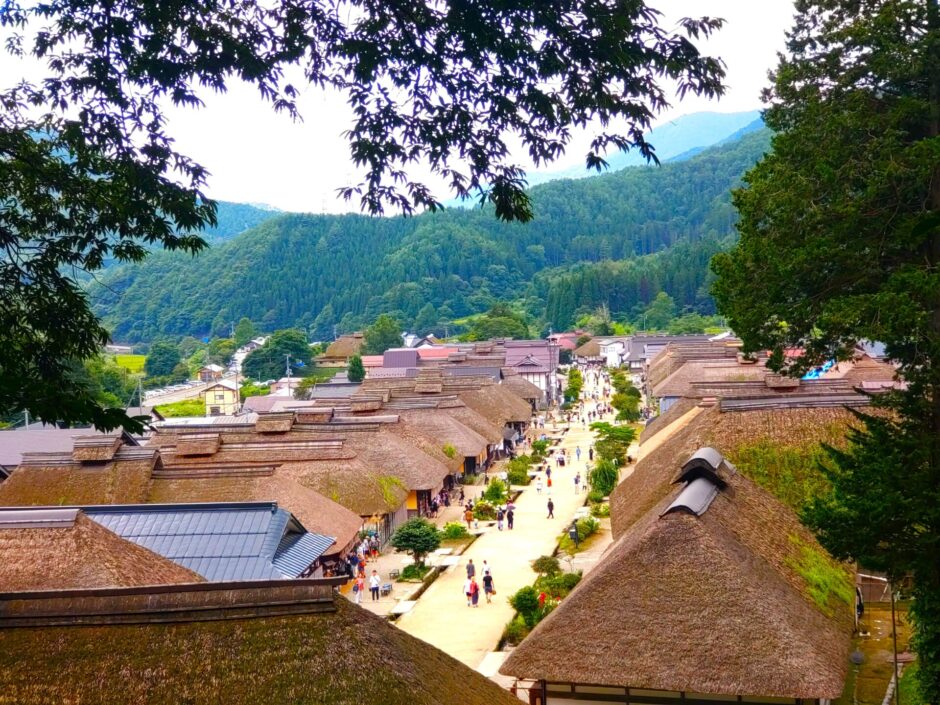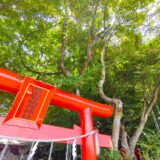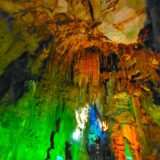【Ouchi-juku summary】
Ouchi-juku is a post town on the Shimotsuke Kaido (Aizu West Highway) connecting Aizu and Nikko in the Edo period (1603-1867). 500m-long thatched-roof buildings from that time still remain. The town has been designated as a National Important Preservation District for Groups of Traditional Buildings, and the entire community is actively working to beautify the town and attract tourists, so that visitors can enjoy beautiful scenery throughout the four seasons.
【Ouchi-juku (look of) stores and houses on street】
![Ouchi-juku [Fukushima] DSC 0834 1 1024x768 - Ouchi-juku [Fukushima]](https://japan-shrine.info/wp-content/uploads/DSC_0834-1-1024x768.jpg)
Ouchi-juku has no power lines and the stream running through the inn is very beautiful.
![Ouchi-juku [Fukushima] DSC 0830 1 1024x768 - Ouchi-juku [Fukushima]](https://japan-shrine.info/wp-content/uploads/DSC_0830-1-1024x768.jpg)
About 40 thatched-roof houses line both sides of a straight road, a living cultural asset where the villagers live.
![Ouchi-juku [Fukushima] DSC 0836 1024x781 - Ouchi-juku [Fukushima]](https://japan-shrine.info/wp-content/uploads/DSC_0836-1024x781.jpg)
Unlike Shirakawa-go, the houses on the street are almost exclusively restaurants or souvenir shops, making it somewhat commercial, but time passes quickly as you visit the unique stores for food and drink, folk art, crafts, and souvenirs.
![Ouchi-juku [Fukushima] DSC 0837 1 1024x768 - Ouchi-juku [Fukushima]](https://japan-shrine.info/wp-content/uploads/DSC_0837-1-1024x768.jpg)
【Ouchi-juku Takakura Shrine Ichino Torii (First Torii)】
![Ouchi-juku [Fukushima] DSC 0833 1024x768 - Ouchi-juku [Fukushima]](https://japan-shrine.info/wp-content/uploads/DSC_0833-1024x768.jpg)
A large torii gate is located in the middle of the streets of Ouchi-juku. The shrine cannot be seen from the torii. If you continue on past the torii gate, you will find Takakura Shrine, which has been revered as the town shrine of Ouchi-juku from the Warring States period to the present day.
![Ouchi-juku [Fukushima] 24586722 m 1024x768 - Ouchi-juku [Fukushima]](https://japan-shrine.info/wp-content/uploads/24586722_m-1024x768.jpg)
The quietness of the area, which is a break from the bustling atmosphere of the Ouchi-juku, creates a solemn atmosphere and a sense of calm.
【Ouchi-juku lookout platform】
![Ouchi-juku [Fukushima] DSC 0818 1024x768 - Ouchi-juku [Fukushima]](https://japan-shrine.info/wp-content/uploads/DSC_0818-1024x768.jpg)
There is a gazebo at the far end of Ouchi-juku. The steps to the gazebo are steep, but the view from here is very beautiful. A little further on, there is Itsukushima Shrine and a small hall dedicated to Benten-sama.
【Ouchi-juku soba with negi onion】
![Ouchi-juku [Fukushima] DSC 0845 1024x749 - Ouchi-juku [Fukushima]](https://japan-shrine.info/wp-content/uploads/DSC_0845-1024x749.jpg)
The specialty of this restaurant is soba (buckwheat noodle) eaten with a single green onion as a chopstick. The way to eat Soba is to hook the Soba on the curved “negi” (green onion) on the white part of the noodle and slurp it up, or nibble on the “chopsticks=green onion” if there is not enough “yakumi” (condiments). Depending on the restaurant, there are some that do not have “chopsticks,” which I thought was difficult for foreign customers.
![Ouchi-juku [Fukushima] DSC 0841 1 1024x768 - Ouchi-juku [Fukushima]](https://japan-shrine.info/wp-content/uploads/DSC_0841-1-1024x768.jpg)
All the stores are renovated from old houses and do not have air conditioners, so they rely on fans. Be sure to drink water and watch out for heat stroke in the summer.
【Ouchi-juku Nearby attractions】
Tsuruga Castle, Sazae Temple, Aizu Buke Yashiki
【Ouchi-juku Access】
Manager’s Comments
The town, which flourished as an inn town in the Edo period, has been preserved in a different form. It is a pity that the town has become quite touristy, but unlike Shirakawa-go, it is not full of foreign tourists, which made me feel nostalgic with its elegant appearance and people. If I have a chance, I would like to visit again during a different season.
 Tour of Japanese shrines and temples
Tour of Japanese shrines and temples 

![Ouchi-juku [Fukushima] 30559332 m 520x300 - Ouchi-juku [Fukushima]](https://japan-shrine.info/wp-content/uploads/30559332_m-520x300.jpg)
![Ouchi-juku [Fukushima] DSC 0893 520x300 - Ouchi-juku [Fukushima]](https://japan-shrine.info/wp-content/uploads/DSC_0893-520x300.jpg)
![Ouchi-juku [Fukushima] DSC 0924 520x300 - Ouchi-juku [Fukushima]](https://japan-shrine.info/wp-content/uploads/DSC_0924-520x300.jpg)
![Ouchi-juku [Fukushima] 26e75bd7f891923913091502321c3013 - Ouchi-juku [Fukushima]](https://japan-shrine.info/wp-content/uploads/sng/26e75bd7f891923913091502321c3013.jpg)
![Ouchi-juku [Fukushima] DSC 0953 150x150 - Ouchi-juku [Fukushima]](https://japan-shrine.info/wp-content/uploads/DSC_0953-150x150.jpg)
![Ouchi-juku [Fukushima] DSC 0786 150x150 - Ouchi-juku [Fukushima]](https://japan-shrine.info/wp-content/uploads/DSC_0786-150x150.jpg)
![Ouchi-juku [Fukushima] DSC 0804 150x150 - Ouchi-juku [Fukushima]](https://japan-shrine.info/wp-content/uploads/DSC_0804-150x150.jpg)
![Ouchi-juku [Fukushima] DSC 0893 150x150 - Ouchi-juku [Fukushima]](https://japan-shrine.info/wp-content/uploads/DSC_0893-150x150.jpg)

